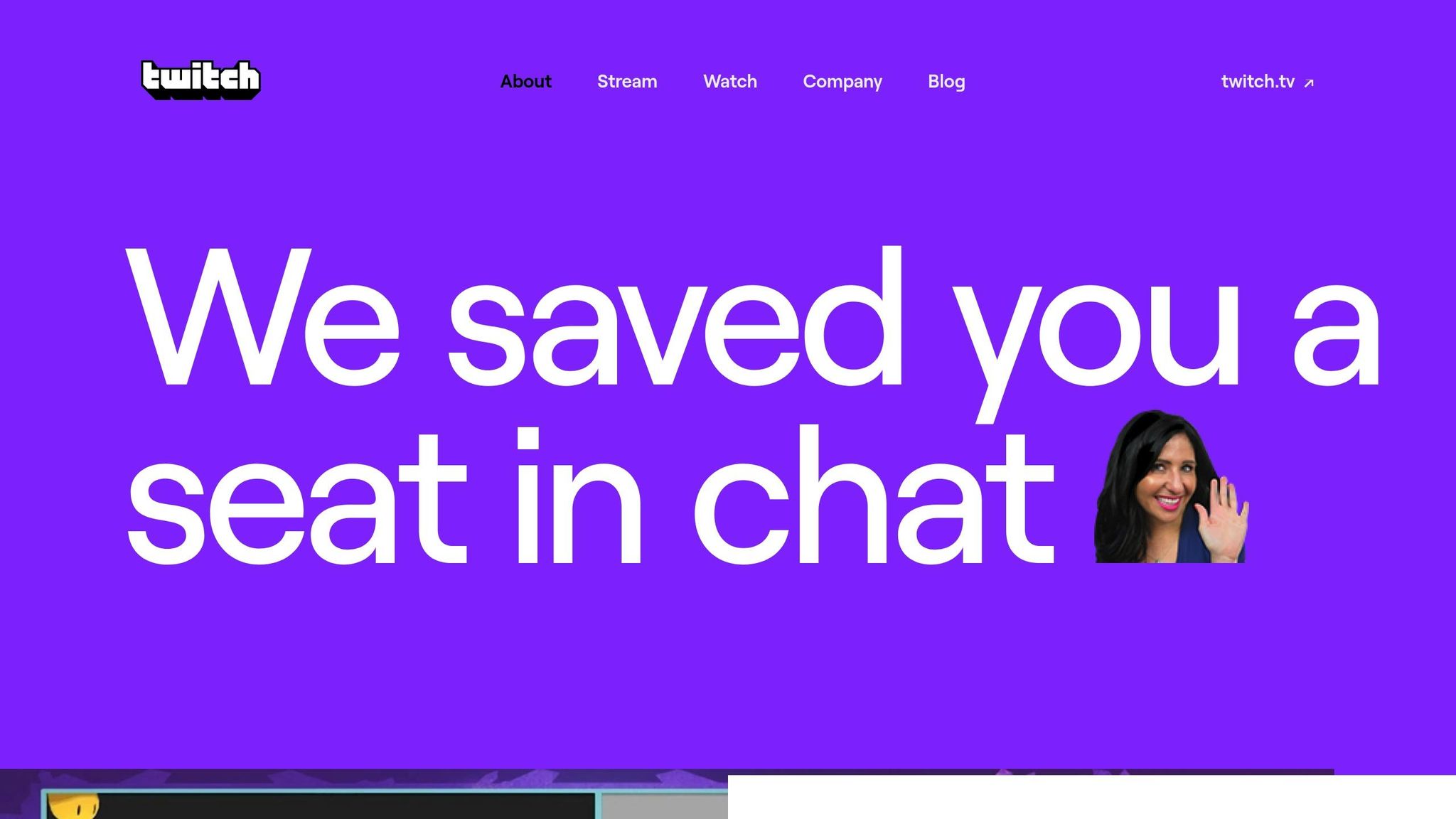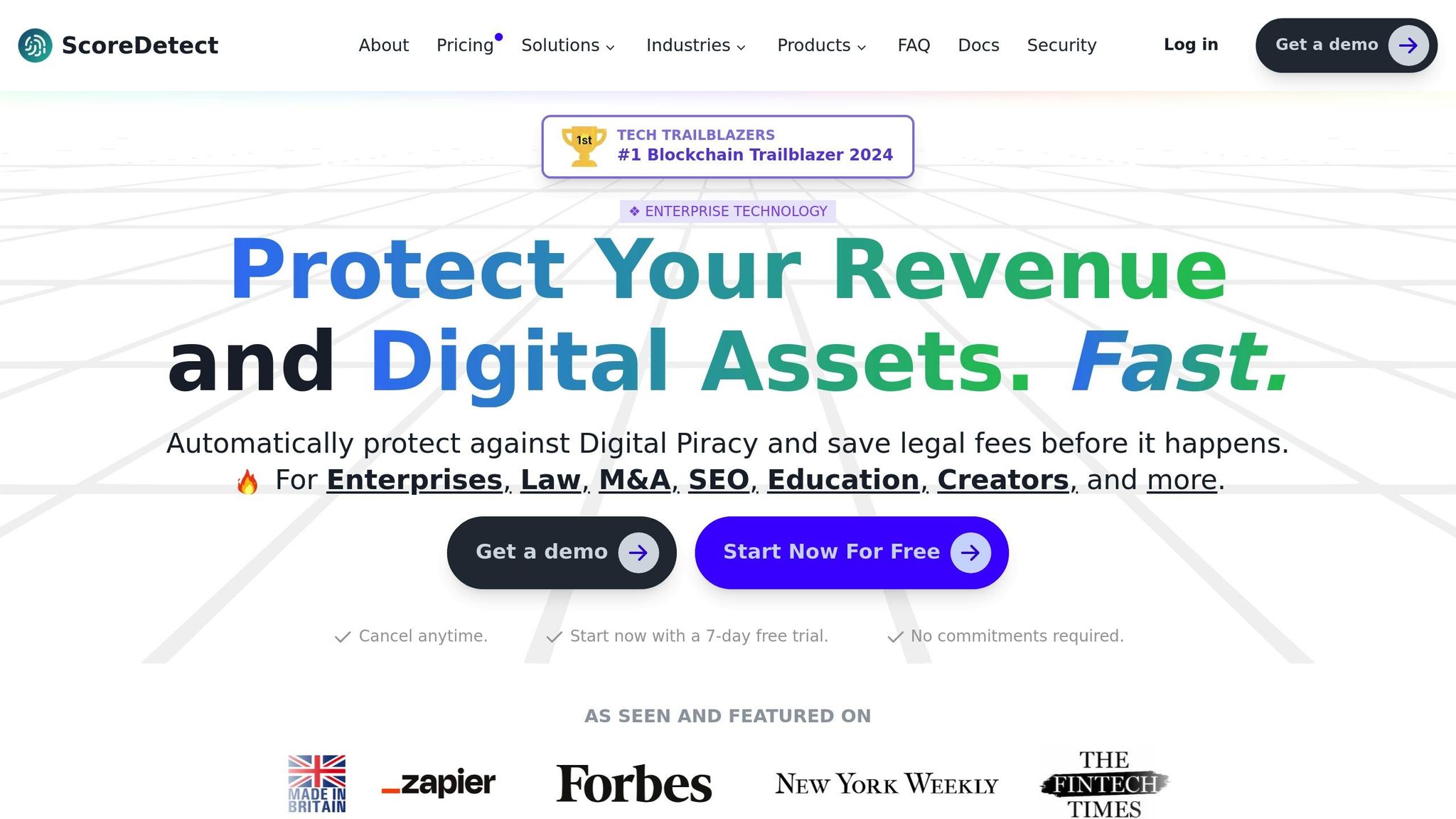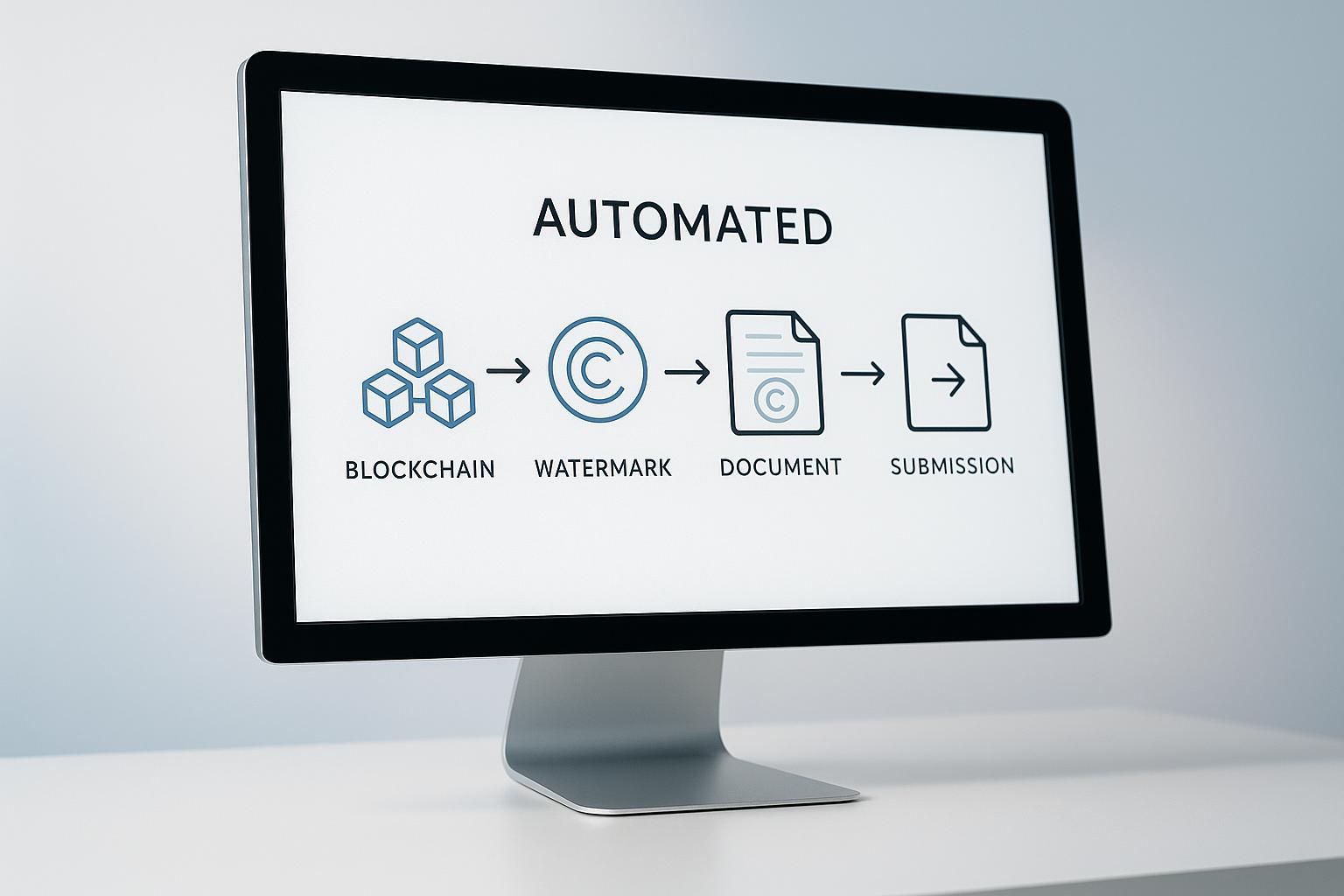Automated takedown systems are transforming how businesses protect digital content, but they come with legal risks. These AI-driven tools detect copyright violations and issue takedown notices, offering speed and efficiency. However, challenges like false claims, malicious misuse, and stricter regulations, such as the new Take It Down Act, are raising concerns.
Key points to know:
- False positives: Legitimate content (e.g., fair use) is sometimes removed by mistake.
- Abuse of systems: Bad actors file fraudulent takedown requests to harm competitors.
- Tighter timelines: Platforms now face stricter deadlines, like 48-hour responses under new laws.
- Liability risks: Errors can expose companies to lawsuits and DMCA violations.
- Free speech concerns: Over-removal threatens expression, especially for transformative works.
To reduce risks, businesses are blending AI with human oversight, improving dispute resolution, and adopting advanced tools like blockchain and watermarking. Balancing speed, accuracy, and compliance is critical as the legal and technological landscape evolves.
Twitch Under DMCA Attack: Let’s Talk Legalities (VL242)

Legal Challenges in Automated Takedown Systems
Automated takedown systems are undeniably efficient at removing infringing content, but they come with legal risks. These challenges arise from the limitations of AI in navigating the complexities of copyright law, leading to several key issues:
False Takedown Claims and System Errors
AI systems can misinterpret content, leading to false takedown claims. For example, works protected under fair use – like educational materials, news reporting, or parodies – are sometimes flagged incorrectly. This puts institutions, journalists, and independent creators at risk of unnecessary removals, which can result in financial and legal consequences.
Another layer of complexity emerges with AI’s difficulty in distinguishing between legitimate AI-generated content and manipulated works, such as deepfakes. As these technologies advance, ensuring that automated systems can accurately evaluate content becomes increasingly critical.
Fraudulent and Malicious Takedown Requests
Some individuals or groups exploit automated systems to file fraudulent takedown requests. These bad actors use the process to suppress criticism or manipulate search results, often targeting competitors or dissenting voices. Such misuse can lead to the unjust removal of important content, causing financial losses or reputational damage. Stronger verification measures are essential to weed out malicious claims and protect legitimate content.
Platform Liability and Legal Accountability
Platforms using automated systems must also navigate the legal tightrope of liability. Missteps in their processes – like failing to provide proper notice-and-counter-notice mechanisms – can jeopardize their safe harbor protections under copyright law. Courts are increasingly pushing for human oversight to ensure accountability, especially when automated decisions are involved.
There’s also growing pressure from regulators to increase transparency. They want platforms to explain how algorithms make decisions and manage errors. This tension between fast responses and thorough reviews means platforms must refine their systems to balance legal compliance with protecting users’ rights.
Impact on Free Speech and Expression
Over-removal of content by automated systems poses a serious threat to free speech. Legitimate criticism, commentary, and artistic expression can be wrongly censored, discouraging creators from publishing content that falls well within legal boundaries. This is particularly problematic for transformative works, where nuanced human judgment is often required to strike a balance between enforcing copyright and preserving freedom of expression.
These challenges highlight the importance of integrating human oversight with automated processes, a topic further explored in the compliance and risk reduction sections. Balancing efficiency with fairness is key to addressing these legal concerns.
U.S. Regulatory and Compliance Requirements
The regulatory environment for automated takedown systems in the U.S. is constantly shifting. Companies need to stay vigilant, keeping up with changing enforcement practices to maintain compliance and safeguard their safe harbor protections.
DMCA Updates and Emerging Legislation
The Digital Millennium Copyright Act (DMCA) remains the cornerstone of online takedown procedures. However, ongoing debates are raising questions about the balance between automated tools and human oversight. These discussions highlight the need for well-defined processes to handle disputes over takedown requests. As these conversations evolve, they’re drawing more attention from government agencies, signaling a growing focus on the regulatory framework.
Increased Scrutiny on Takedown Abuse
Federal authorities are zeroing in on how automated takedown systems are managed, emphasizing the importance of transparency in decision-making and the implementation of safeguards to prevent misuse. This heightened oversight makes it essential for companies to regularly review and strengthen their compliance practices. Updating legal protocols and dispute resolution processes is more important than ever, especially as regulators continue to stress the delicate balance between automation and human intervention within these systems.
sbb-itb-738ac1e
Legal Risk Reduction Strategies for Businesses
To tackle potential legal issues, businesses need to adopt strategies that blend technology with human oversight, establish clear processes for resolving disputes, and leverage advanced tools. These safeguards are essential to protect both the organization and content creators from legal challenges.
Balancing Automation with Human Review
A smart approach combines the efficiency of automated systems with the judgment of human reviewers. Setting clear thresholds for when human intervention is required can help avoid false positives and costly legal battles.
Human oversight is particularly critical in cases involving fair use claims or content that falls into legal gray areas. Having trained reviewers handle these situations minimizes the risk of wrongful takedowns, which could lead to expensive disputes.
Many leading platforms use a tiered review system. High-confidence automated decisions are processed immediately, while more uncertain cases are flagged for human review. This method balances speed with the added legal protection that comes from human judgment, ensuring a more reliable and fair dispute resolution process.
Creating Clear Dispute Resolution Procedures
In addition to human review, establishing clear and accessible dispute resolution processes is key to reducing legal risks. Businesses should offer multiple channels for users to raise disputes, aiming to acknowledge claims within 24–48 hours and provide a resolution within a week.
Transparency plays a big role here. Every takedown decision should include detailed reasoning, relevant evidence, and clear instructions for appealing the decision. This not only builds trust but also provides a legal safety net if disputes escalate to court.
For more complex cases, businesses should have escalation procedures in place. Predetermined criteria for involving legal counsel ensure consistent decision-making and reduce the likelihood of costly errors.
Using Advanced Technology Solutions
Advanced technologies can significantly improve compliance and accuracy. AI-powered tools are particularly effective at distinguishing between legitimate and infringing content, reducing the false positives that often lead to legal complications.
Take ScoreDetect as an example. This platform uses a mix of cutting-edge technologies, including invisible watermarking to prevent unauthorized use, intelligent web scraping, and automated delisting notices. These tools help industries protect their digital assets while staying compliant with regulations.
Blockchain technology is another powerful tool. It creates a tamper-proof record of content ownership and takedown actions, which can serve as crucial evidence in legal disputes. This immutable documentation demonstrates good faith efforts to safeguard intellectual property rights.
Integration capabilities also play an important role. Platforms that connect seamlessly with business tools like Zapier ensure that takedown actions are well-documented and tracked across systems. This comprehensive record-keeping supports both legal defenses and compliance requirements.
ScoreDetect Solutions for Takedown Challenges

ScoreDetect builds on risk management strategies by offering tailored solutions to handle the legal challenges of automated takedowns. By blending advanced technology with compliance safeguards, the platform strikes a balance between protecting intellectual property and managing legal risks. Here’s how its features translate into practical tools for reducing legal exposure.
Compliance Features and Risk Management Tools
ScoreDetect employs invisible watermarking to embed undetectable markers into digital assets, creating a verifiable trail of ownership. This ensures that content ownership can be authenticated when disputes arise.
The platform also leverages blockchain technology to capture content checksums, providing an immutable record of ownership. Coupled with automated DMCA notices, which boast a reported 96% success rate, businesses can enforce their rights effectively while staying compliant with U.S. regulations. This automation reduces the likelihood of legal complications.
Another key feature is web scraping, which identifies unauthorized content with precision. By minimizing false positives, this tool streamlines enforcement and makes takedown operations more efficient. Additionally, integration with over 6,000 web apps via Zapier simplifies the monitoring and takedown process, ensuring seamless content protection.
These tools form the foundation for a wide array of industry-specific applications.
Industry Applications and Use Cases
- Legal Professionals: Use formal recognition certificates and digital timestamping to verify content ownership, offering a reliable way to handle disputes.
- Media and Entertainment Companies: Benefit from continuous monitoring across multiple channels, ensuring their content remains protected against unauthorized use.
- Academic and Educational Institutions: The integrated WordPress plugin automatically captures and protects published research and educational materials. This not only strengthens copyright protection but also improves SEO performance.
- Marketing and Advertising Agencies: Features like custom domain support and white-labeling help safeguard client assets while maintaining brand consistency across various websites.
- Healthcare Organizations: Enterprise-level security measures protect sensitive research data and proprietary content. These tools also ensure compliance with regulatory standards, reinforcing the platform’s focus on legal risk reduction.
- Businesses with Development Needs: Developer API access allows companies to integrate ScoreDetect’s takedown capabilities directly into their content management systems, embedding protection measures into everyday workflows.
ScoreDetect’s suite of tools and applications ensures that businesses across industries can protect their assets efficiently while navigating complex legal landscapes.
Managing Legal Risks in Automated Takedowns
Handling legal risks in automated takedowns requires a well-rounded strategy that prioritizes both efficiency and compliance. Companies must skillfully navigate intricate regulations while safeguarding their intellectual property and steering clear of expensive legal battles. Here’s a closer look at the essential elements for building a strong legal defense.
To start, understanding your legal responsibilities is crucial. Under the DMCA, businesses are required to make good faith efforts to verify ownership before filing takedown requests. This means relying on advanced verification methods rather than simple keyword matching, which can lead to errors.
Keeping detailed records is another critical step. Document ownership, takedown actions, and dispute resolutions thoroughly to establish credibility in any potential legal disputes. Tools like blockchain timestamping can be especially helpful, as they create unchangeable proof of ownership.
Training your team on appropriate takedown procedures is equally important. Employees should be able to distinguish between genuine copyright infringement and protected forms of expression like fair use or parody. Regular training sessions not only ensure consistent decision-making but also lower the chances of accidental or false claims, which can lead to legal challenges.
It’s also wise to monitor takedown metrics and adopt a tiered approach based on the severity of infringements. This proactive method can help reduce disputes while maintaining a high success rate by blending automation with careful verification.
When dealing with international copyright issues, be aware of the differences in laws and enforcement practices across countries. Understanding these variations minimizes legal risks when enforcing rights in multiple regions.
Strong relationships with platforms are another key factor. Clear communication and consistent, legitimate takedown practices can improve response times and foster cooperation in future cases.
Finally, schedule regular consultations with legal experts to ensure your takedown processes remain aligned with evolving copyright laws. Staying ahead of changes in regulations is essential for long-term compliance and risk management.
FAQs
How can businesses reduce false takedown claims and protect their original content?
To guard against false takedown claims and protect your content, it’s essential to use content monitoring tools and keep thorough records of every takedown notice and response. This approach not only promotes transparency but also provides solid evidence if disputes arise.
Leveraging automated content verification tools can further help distinguish genuine claims from fraudulent ones. Collaborating closely with platform providers and customizing takedown notices to comply with local regulations can also enhance accuracy and speed up responses, ensuring your content stays protected.
How do automated takedown systems affect free speech, and what measures can ensure fair enforcement while protecting expression?
Automated takedown systems, while designed to combat copyright infringement, can sometimes overreach and unintentionally remove lawful content. This can stifle free expression and create frustration for both content creators and users who rely on open platforms to share their ideas.
To address this, safeguards are essential. Introducing transparent review processes, establishing clear and accessible legal guidelines, and offering simple, user-friendly appeal systems can make a significant difference. These steps help ensure that copyright enforcement is fair and that legitimate content remains protected, fostering an environment where free expression and lawful sharing can thrive.
What steps can companies take to minimize legal risks when using automated takedown systems?
To reduce legal risks, businesses relying on automated takedown systems need to prioritize precise and legally sound procedures when managing takedown notices. This means keeping a detailed inventory of their digital assets, ensuring all notices align with legal requirements like the DMCA, and thoroughly documenting actions to show they are acting in good faith.
Conducting regular legal audits, consistently monitoring takedown operations, and adopting effective practices are equally important. Using advanced tools with features like automated workflows and comprehensive reporting can simplify compliance efforts and help mitigate potential liabilities.

